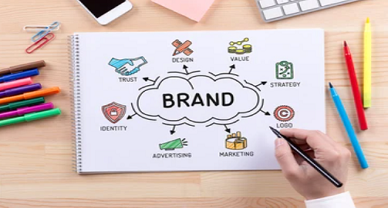Trademark Infringement in the Digital Age
Introduction
In today’s digital economy, trademarks play an important role in developing a brand’s identity, establishing customer trust, and assuring market competition. Corporations must establish online identities, such as logos, slogans, product names, and brands, to build consumer awareness, loyalty, and trust. Trademarks are becoming even more significant assets for companies trying to stand out in a competitive market due to the growth of online platforms and e-commerce. They are among the most valuable intellectual property rights (IPRs) in the digital age since they tend to be the main assets of technological companies and are exchanged on e-commerce platforms.
Trademark violation raises significant issues. The accessibility of Internet markets and the ease with which information may be shared have given rise to new opportunities for trademark infringement. Trademark infringement has grown more complex and pervasive, ranging from counterfeit goods to digital squatting and keyword advertising. Using trademarks in domain names, linking, framing, meta-tagging, and framing are a few methods that could lead to trademark challenges. Cybersquatting is another type of trademark infringement. This seriously threatens the financial interests and intellectual property rights of enterprises.
Trademark Law Before pre-digitalization
The US Trademark Office (USPTO) defines a trademark as a word, phrase, design, or symbol that serves to identify and distinguish the products or services you sell apart from those of others. It facilitates brand recognition and trust among customers. As per the Trade Marks Act, of 1999, a trademark is any symbol that may be visually shown and can differentiate the goods or services of one entity from those of other entities. It may consist of words, devices, labels, numerals, or a mix of these, as well as the form and packaging of the products and a selection of colours.
Before the invention of the digital era, trademark law was mainly concerned with protecting the distinctive names, symbols, and marks that companies used to identify their products and services to customers. Preventing consumer misunderstanding and protecting the goodwill associated with a brand are two of the core trademark law concepts that predate the internet era.
A fundamental tenet of trademark law is to avoid consumers being confused about the origin or source of products or services. This implies that the owner of a trademark has the exclusive authority to use it in connection with certain products or services and that third parties are not permitted to use a mark that is confusing to customers in any manner. In addition, trademark law seeks to safeguard a mark’s good name and reputation among customers. For legal protection, trademarks are often registered with national intellectual property authorities. The goal of trademark law is to strike a balance between the public interest and trademark owners’ rights. This involves avoiding unfair competition and protecting customers.
Traditionally, Trademark Infringement Counterfeiting, passing off, and Trademark Dilution. Dilution of trademarks has been an issue since before the digital era. Even in cases where there is little chance of confusion, it occurs when the unapproved use of a well-known or valued trademark diminishes its distinctive nature or damages its reputation. Typically, counterfeiting happens during the production and delivery of tangible items. Further, when a company uses a similar or identical trademark to falsely portray its goods or services as those of another company, this is known as passing off. Confusion among consumers and damage to the legitimate trademark owner’s reputation may result from this.
To preserve the reputation and avoid customer confusion, trademark protection leaned on several enforcement measures before the digital era. For trademark owners, litigation was their main option. It gave them the ability to sue in court to stop infringement and recover damages for unapproved use of their marks. Trademark owners frequently used cease and desist letters to pressure infringers to stop using their marks without authorization before taking legal action. Governments also supported the efforts by enforcing customs laws, which gave officers the authority to stop the entry of counterfeit products into domestic markets by stopping them at the border. The registration and management of trademarks was another essential component. The core tenets of trademark law—preserving brand integrity and preventing consumer confusion—resisted the infringing strategies that evolved with digitalization.
Trademark Infringement in the Digital Landscape
The internet and digital technology have enabled new types of trademark infringement through channels such as cybersquatting, keyword advertising, and social media misuse, making it more challenging for companies to safeguard their intellectual property rights. While keyword advertising uses trademarked words to divert customers, cybersquatting involves acquiring domain names to benefit from trademarks. also, Misuse of social media involves using trademarks without authorization to mislead or damage companies. These online platforms increase the impact of infringement on consumer trust and brand reputation by facilitating quicker dissemination and greater reach.
Cybersquatting
The practice of registering a domain name that contains a well-known trademark to make a profit out of the goodwill or brand value connected with it. Usually, cybersquatters utilize this strategy to distribute false information, market fake goods, or finally pressure the owner of the trademark into paying a premium price for the domain. Cybersquatting is a type of cybercrime that is prohibited owing to the perpetrator’s malicious intent. It may lead to several issues, including fraud, data breaches, and damage to legitimate organizations’ reputations. Cybersquatting comes in several forms, including as identity theft, name jacking, and typo-squatting.
Typo squatting is the practice of registering domain names that intentionally misspell or alter well-known brand names. Its goal is to profit from any errors that internet users may make. The act of registering domain names that are the same as or close to someone’s name is known as “name jacking.” Often, the goal is to either utilize the domain for identity theft or sell it back to the original owner. Identity theft involves obtaining a company’s digital identity by registering a domain that looks similar to its website. This behaviour could deceive users into installing malware or disclosing sensitive information. It may cause confusion among customers, divert traffic from reliable websites, and harm the reputation of brands, all of which can have a significant impact on users.
The Anticyber Squatting Consumer Protection Act (ACPA) considers cybersquatting unlawful in the United States. Businesses and individuals can utilize real-time anti-cybersquatting protection, proactively purchase similar domain names, and register trademarks to combat cybersquatting. If trademark owners can successfully demonstrate that a cybersquatter has behaved fraudulently, they may be able to pursue legal action in the United States, which may include damages, legal expenses, and injunctive relief. Any laws in India do not specifically address cybersquatting. However, the Indian legal system has been utilizing judicial activism and current legislation to address cybersquatting cases. Although the Trademark Act, of 1999 has limits in terms of offering sufficient protection for domain names, Indian courts have been using it to settle issues about cybersquatting. The judiciary has demonstrated initiative in granting redress in cases involving cybersquatting.
Case Study: Yahoo! Inc. v Akash Arora and Anr,
Yahoo! Inc. filed a lawsuit against Akash Arora for registering the domain name “yahooindia.com” and offering comparable goods and services, which was considered a violation of Yahoo!’s trademark and cybersquatting. This was a major step forward for Indian intellectual property law when the court decided that domain names should have the same level of protection against passing off as trademarks.
Keyword Advertising
Keyword advertising in trademark infringement is the practice of implementing a competitor’s trademarked phrases as keywords in paid search advertisements. Internet advertising initiatives, entail taking advantage of the trademarked terms of another firm as keywords to drive attention to one’s website or product. Customers may get confused as a result, diminishing the trademark’s value.
The customer may be more affected by it. If employing trademarked phrases in keyword advertising confuses customers, there may be legal implications. Owners of trademarks have the right to sue trademark infringers, but they must first establish a likelihood of confusion. Although courts have been reluctant to hold search engines liable for trademarked phrases, they may find advertisers liable. Search engines have policies about trademarked terms. By keeping track of keyword usage, filing complaints, and considering launching their keyword advertising campaigns, trademark owners could protect their brands.
Case law has shaped the legal framework in both India and the US about trademark infringement and keyword advertising. The main laws that deal with trademark infringement in the United States are the Anticybersquatting Consumer Protection Act (ACPA) and the Lanham Act. The Trademarks Act, of 1999 in India, however, does not refer to keyword advertising specifically. Yet in cases involving keyword advertising, the courts have used the concepts of trademark infringement and dilution.
Case Study: Satyam Infoway Ltd. v. Sifynet Solutions Pvt. Ltd. (2004)
The Delhi High Court ruled that if there was a possibility of confusion, using a brand as a keyword in an internet advertising business might be considered trademark infringement.
Case Study: MakeMyTrip India Pvt Ltd v Booking.com BV & Ors (2022)
According to the Delhi High Court, using a registered trademark as a keyword in Google AdWords is considered infringement as it amounts to passing off and taking unfair advantage of the registered mark.
Keyword advertising that violates trademarks gives rise to concerns about customer confusion as well as potential legal repercussions. In situations involving keyword advertising, courts throughout the world have adopted rules for infringement and dilution of trademarks. Therefore, to protect their companies in the digital sphere, trademark owners need to exercise caution, be aware of legislative frameworks, and act decisively.
Social Media Misuse & Counterfeit Sales
To deceive customers, unauthorized entities can create false profiles, pages, or accounts, harming their reputation and possibly costing them money. It may decrease the value of the trademark, deceive customers, and damage the integrity of the brand. Reputational damage leads to lower revenues as consumers avoid doing business with companies that they perceive as negative. Long after infringing information has been removed, negative associations created around unlawfully obtained logos may persist; this tendency is known as “guilt by association.”
Counterfeiters use online marketplaces, social media platforms, and websites to sell counterfeit goods bearing trademarks without authorization. To preserve brand reputation, businesses ought to report fraudulent profiles, regularly monitor social media platforms, and interact with consumers. Companies may prevent counterfeiters from using online platforms by improving their legal standing. Businesses ought to give priority to registering their trademarks. It’s critical to continuously monitor social media and marketplaces for inappropriate behavior using both automatic technologies and manual inspections. Working together with specialist service providers such as Authentix can improve the effectiveness of advanced analytics and investigative teams. Participating in brand protection initiatives, creating reaction strategies, and training stakeholders are also essential. Investing in artificial intelligence (AI)-powered analytical tools, interacting with authorities, and encouraging community involvement strengthen defences against counterfeiters. Lastly, to preserve income streams and maintain brand integrity, businesses should be ready to pursue both criminal and civil penalties against violators. They should also collaborate closely with law enforcement.
Case Study: Louis Vuitton vs. Fake LV
Luxury Businesses Louis Vuitton especially battles various social media accounts that utilize variants of their logo and name, frequently to sell counterfeit items. These accounts harm the company’s reputation by linking it to inferior goods in addition to violating its trademark.
Case study: Apple vs. “Apple iPhone”
A Chinese business violated Apple’s trademarks in 2009 by branding their smartphone the “Apple iPhone”. This case highlights how difficult it may be to enforce trademark protection internationally on social media, where regional limitations might make it more difficult.
The rise of digital technology has also brought out new difficulties, like Domain Name Disputes. Due to the worldwide reach of internet platforms, businesses must implement preventative measures such as keeping an eye on domain registrations and utilizing procedures for domain name disputes such as the Uniform Domain-Name Dispute-Resolution Policy (UDRP) to prevent trademark infringement on a global scale. To maintain their trademark rights while allowing user engagement, businesses should establish guidelines for user-generated content and a takedown procedure for infringing content.
Challenges in Protecting Trademarks Online
Trademark owners encounter difficulties in protecting their rights online due to several variables such as navigating diverse internet platforms, anonymous infringers, and complicated jurisdictions. This selection will draw attention to the shortcomings of traditional trademark enforcement techniques in the context of digital media.
Jurisdictional Complexities
Establishing the proper jurisdiction can be challenging in online contexts due to the possibility of worldwide infringement. Businesses struggle to negotiate numerous nations’ differing legislation and processes for providing complaints and beginning actions against infringers.
Case study: Google Inc. v Equustek Solutions Inc.
A decision by the Canadian Supreme Court in which British Columbian courts ordered Google to erase search results of websites that advertised counterfeit goods internationally. Although this established a precedent for injunctions that are valid outside of Canada, it also raised concerns about international enforcement strategies and possible legal inconsistencies.
Anonymity of Infringers
Anonymous actors make it difficult to identify defendants, hindering the service of notice and delivery of cease requests. The inability to identify the parties at fault makes taking legal action nearly impractical.
Rapid Proliferation of Online Platforms
The rapid growth of digital platforms poses significant difficulties in maintaining uniform supervision and promptly reacting. There’s a constant supply of web domains, apps, games, and social networks to keep updated on as new technologies emerge. It is challenging for businesses to continue to be up-to-date and efficiently maintain their internet presence in this ever-changing world. In addition to this, it is harder to provide thorough oversight as well as fast reaction times. As a result, businesses must constantly develop and modify their monitoring and response plans to deal with this ever-shifting environment.
Limited Control over Third-Party Platforms
Limited control over third-party platforms, where trademark infringement frequently happens, presents serious issues for trademark owners. Although platforms provide trademark infringement notifications, the results vary based on jurisdictional variations as well as aspects like gravity and provided proof. Enforcement attempts are further complicated by geographical limits, fair use defenses, and disparities in legal systems across international borders. It will need a consistent commitment to developing standards of excellence, keeping up with legal changes, investing in trustworthy monitoring methods, and working with stakeholders to overcome these obstacles. In a digitally linked world, maintaining the sustainability of trademark portfolios requires striking a balance between the aggressive and prudent pursuit of criminals.
Limited Traditional Mechanism
Traditional approaches, primarily intended for physical marketplaces, have challenges in cyberspace. There is confusion when it comes to applying traditional standards to new circumstances given by virtual worlds and interactive experiences since commercial use definitions vary depending on case precedents.
Arguments for fair use provide extra obstacles, occasionally allowing creatives to lawfully include protected parts. Furthermore, even if there are duties to control inappropriate usage, keeping ongoing surveillance is difficult. Finally, while alternative strategies including middlemen like hosting companies and search engines have potential, they cannot entirely replace legal processes.
Conclusion
In the digital era, trademark infringement poses complex problems requiring for creative solutions. Online platforms enable activities like cybersquatting, keyword advertising, and social media misuse despite the existence of regulatory frameworks, which pose serious risks to organizations’ intellectual property rights and reputation. Complications with jurisdiction and the anonymity of infringers provide challenges for traditional enforcement strategies. On the other hand, newer technologies like artificial intelligence present opportunities for more effective trademark enforcement. To create a complete strategy, companies, governmental organizations, and internet platforms need to collaborate.
Businesses can improve trademark protection and maintain brand integrity in the digital sphere by combining technology solutions with legal frameworks and promoting collaboration. Effectively managing the changing challenges of online trademark protection requires creativity and adaptation. Companies may reduce the risks associated with trademark infringement and maintain the sustainable existence of brands in an increasingly online marketplace by taking early steps and forming strategic collaborations.
Author: Shejal Sharma , in case of any queries please contact/write back to us at support@ipandlegalfilings.com or IP & Legal Filing.
References
- https://www.americanbar.org/groups/intellectual_property_law/publications/landslide/2019-20/march-april/combating-online-infringement-real-world-solutions-evolving-digital-world/
- https://ai-law.co.uk/navigating-trademark-protection-challenges-in-the-digital-age-a-comprehensive-guide/
- http://www.canlii.org/en/ca/scc/doc/2017/2017scc40/2017scc40.html
- https://www.theipmatters.com/post/yahoo-inc-v-akash-arora
- https://www.upcounsel.com/keyword-advertising-trademark-infringement
- https://lawdit.co.uk/readingroom/intricacies-of-trademark-infringement-in-the-digital-age
- https://www.wallarm.com/what/cybersquatting
- https://www.worldtrademarkreview.com/article/courts-examine-keyword-advertising-trademark-infringement




